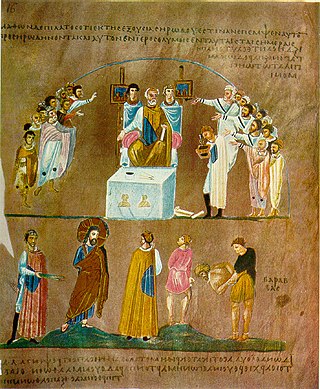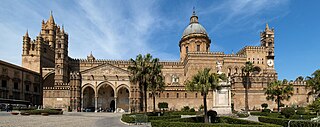
The Rossano Gospels, designated by 042 or Σ, ε 18 (Soden), held at the cathedral of Rossano in Italy, is a 6th-century illuminated manuscript Gospel Book written following the reconquest of the Italian peninsula by the Byzantine Empire. Also known as Codex purpureus Rossanensis due to the reddish-purple appearance of its pages, the codex is one of the oldest surviving illuminated manuscripts of the New Testament. The manuscript is famous for its prefatory cycle of miniatures of subjects from the Life of Christ, arranged in two tiers on the page, sometimes with small Old Testament prophet portraits below, prefiguring and pointing up to events described in the New Testament scene above.

Domenico di Michelino (1417–1491) was an Italian Renaissance painter who was born and died in Florence. His real name was Domenico di Francesco. The patronymic "di Michelino" was adopted in honour of his teacher, the cassone painter Michelino di Benedetto, by whom no works have been identified. Giorgio Vasari reports that Domenico was also a pupil of Fra Angelico, whose influence is reflected in many of Domenico's paintings along with that of Filippo Lippi and Pesellino.

Rossano is a town and frazione of Corigliano-Rossano in the province of Cosenza, Calabria, southern Italy. The city is situated on an eminence c. three kilometres (1.9 mi) from the Gulf of Taranto. The town is known for its marble and alabaster quarries.

Palermo Cathedral is the cathedral church of the Roman Catholic Archdiocese of Palermo, located in Palermo, Sicily, southern Italy. It is dedicated to the Assumption of the Virgin Mary. As an architectural complex, it is characterized by the presence of different styles, due to a long history of additions, alterations and restorations, the last of which occurred in the 18th century.
Cerenzia is a town, comune (municipality), former bishopric and Latin titular see with a population of 1000 people in the province of Crotone, in Calabria region, southernmost peninsular Italy.
Santissima Annunziata may refer to:

The Italian Catholic Archdiocese of Rossano–Cariati in Calabria has existed since 597, beginning as the Diocese of Rossano. It is a suffragan of the Archdiocese of Cosenza-Bisignano.

The Italian Catholic diocese of Cariati, in Calabria, existed until 1979. In that year it was united into the archdiocese of Rossano-Cariati. The diocese was a suffragan of the archdiocese of Santa Severina, and then of the archdiocese of Reggio Calabria. In 2001, it became a suffragan of the Archdiocese of Cosenza-Bisignano.

Bari Cathedral, or Cathedral of Saint Sabinus, is the cathedral of Bari, in Apulia, southern Italy. The cathedral is the seat of the Archbishop of Bari-Bitonto, as it was previously of the archbishops, earlier bishops, of Bari. It is dedicated to Saint Sabinus, a bishop of Canosa, whose relics were brought here in the 9th century. It is senior to, though less famous than, Apulia's Basilica of St Nicholas.

Amalfi Cathedral is a medieval Roman Catholic cathedral in the Piazza del Duomo, Amalfi, Italy. It is dedicated to the Apostle Saint Andrew whose relics are kept here. Formerly the archiepiscopal seat of the Diocese of Amalfi, it has been since 1986 that of the Diocese of Amalfi-Cava de' Tirreni.

Matera Cathedral is a Roman Catholic cathedral in Matera, Basilicata, Italy. It is dedicated to the Virgin Mary under the designation of the Madonna della Bruna and to Saint Eustace. Formerly the seat of the Bishops, later Archbishops, of Matera, it is now the cathedral of the Archdiocese of Matera-Irsina.

Antonio del Massaro da Viterbo, or Antonio da Viterbo, nicknamed il Pastura was an Italian painter.

Otranto Cathedral is a Roman Catholic cathedral in the Italian city of Otranto, dedicated to the Annunciation of the Virgin Mary. It is the archiepiscopal seat of the Archdiocese of Otranto. The cathedral was consecrated in 1088. It is 54 metres long by 25 metres wide and is built on 42 monolithic granite and marble columns from unknown quarries. Its plan is a three-aisled nave with an apsidal east end. On either side of the west façade are two lancet windows.

Lanciano Cathedral dedicated to the Virgin Mary as Santa Maria del Ponte is the duomo of Lanciano in Chieti, Italy, and the cathedral church of the Archdiocese of Lanciano-Ortona. In February 1909 Pope Pius X raised it to the status of minor basilica.
The Diocesan museum of Genoa is located in Genova in the region of Liguria. It is found inside the old residence of the canons of the Cathedral of San Lorenzo and is accessible through the cloister of San Lorenzo. The cloister, built in the 12th century, is characterized by two levels of arches resting on double Romanesque columns with leaved capitals. In the 17th century two sides of the building were modified, with the double columns substituted with heavy pilasters in order to support the above two floors constructed for additional space. The museum houses objects from the diocese of Genoa and the surrounding area, including sculptures, paintings, frescoes, illuminated manuscripts, and a series of liturgical items, as well as an archeological area.
The Diocesan Museum of Palermo is a museum of religious art in Palermo on Sicily, housed in a number of rooms in the Palazzo Arcivescovile opposite Palermo Cathedral.

The Diocesan Museum of Pavia was founded in 2023 on the initiative of the Diocese of Pavia with the aim of protecting, enhancing and making known the artistic treasures of the diocese within the spiritual context that inspired them.














